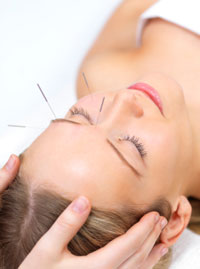A new study concludes that acupuncture is effective for relieving headaches. Investigators note that acupuncture reduces the intensity and duration of headaches. In addition, they suggest that acupuncture can reduce the need for “drug therapies and is a valuable option for patient suffering from CDH [chronic daily headache].”
 In this controlled study, verum acupuncture was compared with sham acupuncture. The verum acupuncture group improved significantly over the control group. Verum acupuncture significantly reduced the frequency, intensity and duration of chronic daily headaches. The research notes that acupuncture is effective for reducing the intensity of pain for chronic tension headaches and migraines. In addition, patients suffering from nausea due to headaches and migraines showed a significant decrease in nausea levels.
In this controlled study, verum acupuncture was compared with sham acupuncture. The verum acupuncture group improved significantly over the control group. Verum acupuncture significantly reduced the frequency, intensity and duration of chronic daily headaches. The research notes that acupuncture is effective for reducing the intensity of pain for chronic tension headaches and migraines. In addition, patients suffering from nausea due to headaches and migraines showed a significant decrease in nausea levels.
In related recent research, acupuncture was found more effective and safer than a migraine medication. Researchers discovered that acupuncture effectively reduced migraine pain intensity levels and no adverse effects occurred. In the same study, patients receiving the medication valproic acid did not have the same level of clinical benefits as acupuncture and with nearly 50% of patients experiencing adverse side effects from the drug.The outcomes were measured six months after the study had been completed. This demonstrates that acupuncture has long term benefits for patients with migraines and that it is both safe and effective.
A massive meta-analysis study measuring patient outcomes of nearly 18,000 patients concurs with the researchers. The study finds that acupuncture effectively treats neck, back, osteoarthritis, headache and shoulder pain. Published in the Archives of Internal Medicine, the researchers concluded that, “Acupuncture is effective for the treatment of chronic pain and is therefore a reasonable referral option.” US Navy sports medicine Dr. Stuessi concurs, “I’ve found phenomenal, off-the-charts results doing acupuncture for sleep, for dizziness and headaches.”
Acupuncture for pain control has received a great deal of attention in modern research. A study conducted at the University of California (San Francisco) discovered that acupuncture provides the same level of pain relief as morphine. The laboratory experiment revealed that needling ST36, an acupuncture point located on the lower leg, significantly reduces jaw pain. After one minute, the pain level reduced by over 20% and after thirty minutes of acupuncture treatment the pain level reduced by 30%. This acupuncture procedure provided the same level of pain relief that is made possible by one dose of morphine.
According to Traditional Chinese Medicine (TCM) theory, acupuncture point ST36 is located along a channel of other points starting in the head and terminating in the feet. ST36 is on the Stomach channel, which is also referred to as the Foot-Yangming Meridian. This acupuncture channel originates at another acupuncture point, LI20, runs to the inner canthus of the eye to an acupuncture point called UB1 and then descends to the gums and joins with yet another acupuncture point called DU26. The Foot-Yangming channel then circles around the mouth, meets with acupuncture point CV24 and then follows the angle of the jaw. Other details of Chinese medicine theory demonstrate that the various branches of the Foot-Yangming Stomach channel connect to the head, mouth, gums and jaw and therefore are consistent with the research demonstrating that acupuncture point ST36 relieves jaw pain.
The mounting evidence from both primary and secondary research demonstrates that acupuncture has significant effective actions in controlling pain. Acupuncture is a covered benefit in many health insurance plans, is used by the US military for the treatment of pain and PTSD and is supported by a deluge of research from prestigious universities. That, combined with publication of supportive research published in important medical journals, suggests that acupuncture is now entering a more mainstream branch of medicine.
References:
SOZEN, AYSE, et al. "EFFECTIVENESS OF ACUPUNCTURE FOR THE TREATMENT OF CHRONIC DAILY HEADACHE: A SHAM-CONTROLLED CLINICAL TRIAL." Acta Medica 29 (2013): 167.
Facco, E., et al. "Acupuncture Versus Valproic Acid In The Prophylaxis Of Migraine Without Aura: A Prospective Controlled Study." Minerva anestesiologica (2013).
Vickers AJ, Cronin AM, Maschino AC, et al. Acupuncture for Chronic Pain: Individual Patient Data Meta-analysis. Arch Intern Med. Published online September 10, 2012. doi:10.1001/archinternmed.2012.3654.
Goddard, Greg. "Acupuncture (ST 36) Reduces Jaw Open Reflex in a Rat: A Pilot Study." (2013). Vickers AJ, Cronin AM, Maschino AC, et al. Acupuncture for Chronic Pain: Individual Patient Data Meta-analysis. Arch Intern Med. Published online September 10, 2012.

